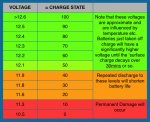We only wildcamp (and in wintertime) and depend on 2 banks of 12v Leisure Batteries to run all our on-board power requirements including our KvH Trackvision Dome Satellite system, LCD TV & Sky+ Box as well as a DVD Player and a Freeview Box. I also use a Laptop PC. The Sky+ Box and the DVD & Freeview units and my Laptop are all supplied by an
Inverter.
To ensure that our basic power needs are never compromised by the entertainment equipment I had a separate bank of 2 x 12v 120Ah Lead Acid Leisure Batteries fitted in a spare exterior locker and a Sterling 50A
Battery to
Battery Charger to charge these from the vehicle's (120A) alternator.
Our lighting, pump, cooker ignition, extractor fan, central heating circulation fan are all supplied by the existing 2 x 90Ah Leisure Batteries which the on-board Sargent EC225 Power Control unit charges - from mains when at home and from the vehicle's alternator when driving.
I learned that the on-board vehicle alternator, although of more than enough capacity at 120A, unfortunately is governed by the vehicle's starter
battery and that as soon as that
battery shows a high enough voltage to the alternator (having been recharged sometime after start-up) then to prevent overcharging the alternator's regulator switches to trickle charge which is useless for charging the Leisure Batteries.
The ideal solution would be fit a separate alternator (a major task for most vehicles and owners) which would only charge the Leisure Batteries. The easier (and does not interfere with vehicle warranties) is the Sterling B2B route - which is widely used on sea-going boats as well as now increasingly on motorhomes. The use of cheaper Lead Acid Batteries is because they fare better with fast high amperage charging and in fact the B2B helps to de-sulphinate them (a common cause of
battery failure). The B2B and extra
battery system described above would cost you about £500-£600 with all cables (50Amp and therefore hefty and costly), clips, cable channel/conduit,
battery boxes, fuses (both ends), output terminals,
battery clamps if done yourself or add 6+ man hours @ £40/hr to have it doe professionally.
We recently spent 10 days without any mains power whilst wildcamping in Ireland and never ran out of power. I did occasionally run the engine for 20 minutes or so just in case - to top up the batteries - before the evening drew in. The Sterling devotes the first 2.5mins to topping-up the starter
battery before then switching to charging the Leisure Batteries (the 2 new ones in our case) at up to 50 Amps. The on-board Sargent ECU only delivers up to 5 Amps I believe to each of the two existing Leisure Batteries - which would be fairly useless - if we did not have our high power-hungry equipment connected to our separate B2B & 2x120Ah
Battery system.
Rowlands Marine, Pwllheli are a brilliant and experienced supplier and installer if you want it all done for you (including the KvH Sat system). That's who fitted us out and with a no-nonsense let's fit the best and most economical friendly service - totally reliable and honest.
James

